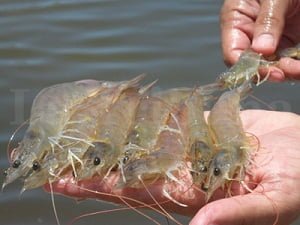
Shrimp farmers understand the importance of providing the right amount of food at the right time. But with traditional methods, it can be challenging to control feeding activity and ensure optimal growth.
But how do shrimp breeders know when their tiny larvae are hungry? Believe it or not, shrimp communicate through clicks generated by their jaws during feeding. Nowadays, there are several methods available for monitoring shrimp feeding behavior.
Clicks, also known as shrimp snaps (small sounds produced by their jaws during feeding), are the key to revolutionizing shrimp feeding practices.
A team of researchers from the Universidade Federal Rural de Pernambuco (UFRPE) evaluated the acoustic parameters of clicks during feeding activity of Penaeus vannamei postlarvae up to 12 g in laboratory conditions.
The “science” of shrimp clicks
It all began with a puzzling observation: a sound emanating from shrimp ponds. Early studies linked this sound to shrimp feeding activity, suggesting it could be used to estimate shrimp populations. Further research identified the origin of the clicks: the jaws, which clash when shrimp eat. This paved the way for new and exciting applications.
By analyzing these clicks (frequency, power, duration), scientists can use a technology called Passive Acoustic Monitoring (PAM) to develop acoustic feeders. These feeders “listen” to the clicks and adjust feeding according to shrimp size and feeding activity. The results are impressive: increased productivity, better growth performance, and higher profits for shrimp farmers compared to traditional methods.
Acoustic feeders
Studies have shown that acoustic feeders can significantly improve food management and shrimp growth compared to traditional methods. This translates to increased productivity and profitability for shrimp producers.
While acoustic feeders are immensely promising, there is a challenge. Current technology is optimized for larger shrimp (over 5 grams). During the early stages (30-40 days), when shrimp weigh less than 2 grams, their clicks are too weak for feeders to efficiently detect. This can lead to insufficient feeding, hindering growth in this crucial developmental phase. Understanding why smaller shrimp produce weaker clicks is key to overcoming this obstacle.
Listening to shrimp postlarvae
Recent research is shedding light on factors influencing click characteristics. Studies show that extruded feed produces stronger clicks compared to granulated feed. Interestingly, the pellet size itself does not affect the click, but longer pellets cause more clicks to be emitted during feeding. Shrimp size also influences: larger shrimp generate clicks with more energy than their smaller counterparts. This reflects observations in other crustaceans, such as lobster, where larger individuals produce louder sounds.
The UFRPE researchers’ study investigated clicks produced by Pacific white shrimp (Penaeus vannamei) from larvae to adulthood (0.01 to 12 grams). Researchers placed shrimp in tanks lined with sound-absorbing foam and recorded their feeding clicks using a special underwater microphone. Then, using Raven® software, they analyzed these clicks, focusing on properties such as frequency, power, and duration.
What the sounds revealed
Here’s the interesting part: the study found that shrimp start clicking from 0.01 grams, even when they are tiny larvae! These clicks have a characteristic frequency range (from 15.4 to 70.5 kHz) and are initially very quiet. As shrimp grow, clicks become louder (higher maximum power) and have a slightly lower pitch (lower maximum frequency). Interestingly, clicks do not appear to elongate as shrimp mature.
The study also revealed a fascinating connection: the size of a shrimp’s jaws directly influences the clicks it produces. This means that by analyzing clicks, we can potentially estimate the size and developmental stage of the shrimp!
Optimizing food delivery: the future lies in clicks
This research paves the way for a new era in shrimp aquaculture. By understanding shrimp clicks, we can develop acoustic-based automatic feeders. These feeders could “listen” to the clicks and adjust food delivery based on shrimp size and feeding activity, ensuring they receive the optimal amount of food throughout their growth cycle.
Conclusion
While this study is a significant step forward, there is more to explore. Future research could investigate how factors such as water quality and feed type affect click characteristics. Additionally, refining click analysis techniques could lead to even more precise feeder adjustments.
Overall, shrimp clicks are no longer just a peculiar sound. They are a valuable tool for shrimp producers, as they have the potential to optimize feeding practices, improve shrimp health, and ultimately increase aquaculture productivity.
Contact
Silvio Peixoto
Departamento de Pesca e Aquicultura, Universidade Federal Rural de Pernambuco (UFRPE), Recife, Brazil
Email: silvio.peixoto@gmail.com
Reference
Hamilton, S., De Moura, G. J. B., Filho, F. C., Craveiro, C., Castro-Neto, H., Almeida, M., Duarte-Neto, P. J., Soares, R., & Peixoto, S. (2024). Size matters: Variability in the acoustic parameters during feeding activity of Penaeus vannamei in different size classes. Aquaculture, 587, 740843. https://doi.org/10.1016/j.aquaculture.2024.740843

